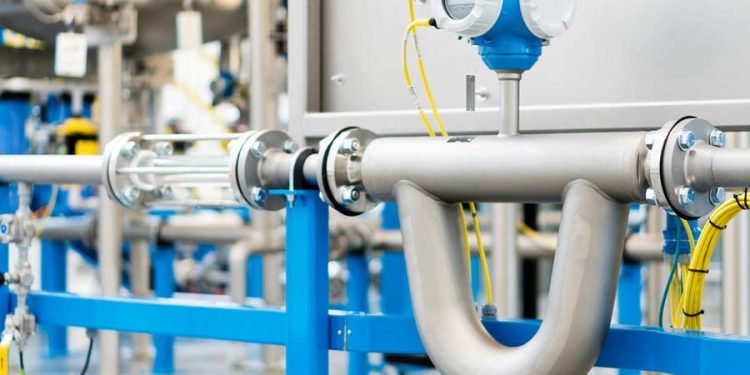Coriolis flow meters have been used for decades to measure the flow rate of liquids and gases in various industries such as oil and gas, chemical processing, and food and beverage. As technology advances, the future of coriolis flow meters holds promising trends and innovations. In this article, we will explore the latest trends and innovations in coriolis flow meters.
Coriolis flow meters are devices used to measure the mass flow rate of liquids and gases. They work on the principle of Coriolis effect, which causes a tube or tubes to oscillate in response to the mass flow rate passing through them. These oscillations are detected by sensors, and the flow rate is calculated based on the phase difference between the oscillations.
Coriolis flow meters have been used in various industries for decades, and their importance in flow measurement cannot be overstated. However, with the advent of new technologies, the future of coriolis flow meters looks even more promising. In this article, we will discuss the emerging trends and innovations in coriolis flow meters.
Emerging Trends in Coriolis Flow Meters
Trend 1: Miniaturization
Miniaturization is a trend that has been gaining popularity in various industries, including the flow measurement industry. Miniaturized coriolis flow meters are smaller and lighter than traditional ones, making them easier to install and use in applications where space and weight are critical factors.
Miniaturized coriolis flow meters also offer improved accuracy, which is a crucial factor in flow measurement. They can measure even small flow rates accurately, making them suitable for applications such as fuel injection systems, where accurate measurement of fuel flow rates is essential.
Trend 2: Wireless Connectivity
Wireless connectivity is another trend that is gaining popularity in the flow measurement industry. Wireless coriolis flow meters can be connected to a network, allowing remote monitoring and control of flow rates. They can also be connected to other devices such as smartphones and tablets, making it easier for operators to monitor and control flow rates on the go.
Wireless coriolis flow meters also offer improved accuracy and reliability. They eliminate the need for physical connections between the flow meter and the control system, reducing the risk of errors caused by loose connections or faulty cables.
Trend 3: Increased Accuracy
Accuracy is a crucial factor in flow measurement, and coriolis flow meters have been known for their high accuracy for decades. However, with the advent of new technologies, coriolis flow meters are becoming even more accurate.
Innovations such as digital signal processing and advanced algorithms are being used to improve the accuracy and reliability of coriolis flow meters. These technologies can compensate for factors such as temperature, pressure, and viscosity, which can affect flow rate measurements.
Trend 4: Multiphase Flow Measurement
Multiphase flow measurement is another emerging trend in the flow measurement industry. Multiphase flow refers to the flow of multiple phases, such as gas, liquid, and solid, in a single pipeline.
Coriolis flow meters are being developed to measure multiphase flow accurately. These flow meters can distinguish between the different phases and measure their flow rates accurately, making them suitable for applications such as oil and gas production, where accurate measurement of multiphase flow rates is essential.
Trend 5: Integration with Other Sensors
Integration with other sensors is a trend that is gaining popularity in various industries. Coriolis flow meters are being integrated with other sensors such as temperature and pressure
As mentioned earlier, one of the major trends in Coriolis flow meters is the move towards digitalization. This has been driven by the need for increased accuracy and efficiency, as well as the desire for more convenient and streamlined operations. With the use of digital Coriolis flow meters, it is possible to monitor fluid flow rates in real-time, with greater precision and accuracy.
Another important trend in Coriolis flow meters is the use of new materials and manufacturing processes. Manufacturers are constantly looking for ways to improve the performance and durability of their flow meters, and are experimenting with new materials and production techniques to achieve these goals. For example, some companies are using advanced polymers and composite materials to make their flow meters more corrosion-resistant and durable, while others are using new 3D printing technologies to produce flow meters with more complex geometries and improved performance.
In addition to these trends, there are also several emerging innovations in Coriolis flow meters that are worth noting. One of these is the development of wireless Coriolis flow meters, which use Bluetooth and other wireless technologies to transmit data to a remote location for analysis and monitoring. This allows for more convenient and flexible monitoring of fluid flow rates, without the need for extensive wiring and cabling.
Another emerging innovation in Coriolis flow meters is the use of artificial intelligence (AI) and machine learning algorithms to improve their performance and accuracy. By analyzing large amounts of data from multiple sensors, these algorithms can identify patterns and trends in fluid flow rates, and adjust the flow meter settings to optimize performance and accuracy.
Finally, there is also ongoing research into the use of micro-electromechanical systems (MEMS) for Coriolis flow meters. These tiny devices use micro-scale sensors and actuators to measure fluid flow rates with incredible precision, and are being developed for a range of applications, from biomedical research to microfluidics. See more here about coriolis flow meter installation
In conclusion, Coriolis flow meters have come a long way since their invention in the 1970s, and are now a crucial technology for a wide range of industries, from oil and gas to pharmaceuticals and food production. With the ongoing trends towards digitalization and new materials, as well as the emerging innovations in wireless technology, artificial intelligence, and MEMS, we can expect to see even more exciting developments in Coriolis flow meters in the years ahead.
FAQs:
Q: What is a Coriolis flow meter?
A: A Coriolis flow meter is a device that measures the mass flow rate of a fluid, based on the Coriolis effect.
Q: What are some of the advantages of Coriolis flow meters?
A: Coriolis flow meters offer high accuracy, low maintenance, and a wide range of measurement capabilities.
Q: What industries use Coriolis flow meters?
A: Coriolis flow meters are used in a wide range of industries, including oil and gas, pharmaceuticals, food production, and more.
Q: What are some emerging trends in Coriolis flow meters?
A: Some emerging trends in Coriolis flow meters include digitalization, new materials and manufacturing processes, wireless technology, artificial intelligence, and micro-electromechanical systems (MEMS).
Q: How do Coriolis flow meters compare to other types of flow meters?
A: Coriolis flow meters offer advantages over other types of flow meters in terms of accuracy, low maintenance, and a wide range of measurement capabilities.












